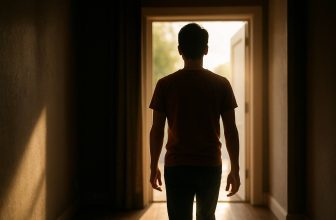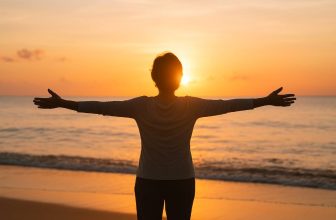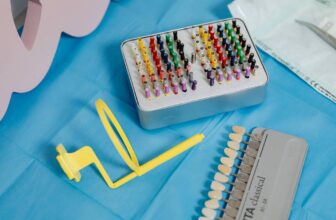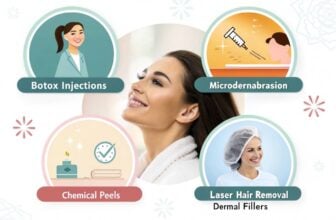Red light therapy is emerging as a natural, noninvasive solution to optimize your sleep cycle while enhancing skin, hair, and overall wellness.
Imagine unwinding under a gentle red glow that soothes your body and helps regulate your internal clock. By tapping into the science of circadian rhythms, this therapy offers hope for better sleep quality and improved health.
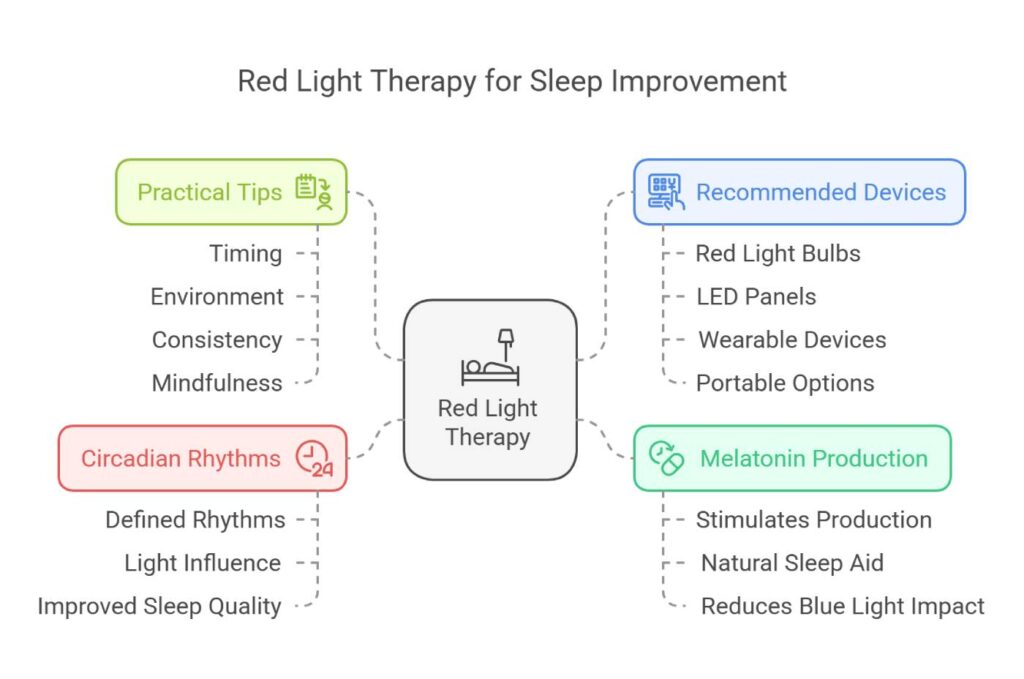
In this article, we explore breakthrough studies, user benefits, and practical tips to integrate red light into your bedtime routine—inviting you to discover a luminous path to a healthier, more balanced life.
Understanding Red Light Therapy
Impact on Sleep Troubles
Red light therapy, or just waving the magic glow wand, as some might say, has caught the spotlight for possibly helping folks with sleep issues. While the jury’s still out on how much this light can really tuck you in, some studies shine a good light (pun intended!) on its benefits.
This light isn’t just out here doing one job; it’s also handling your skin’s glow, getting your hair to sprout, patching up aches, and sorting out boo-boos. It’s your all-round bedside helper.
We’ve dipped our toes into the research pool, but it’s still a bit shallow. But hey, strides have been made! Remember that gang of 20 female basketball players in China back in 2012? Their zzz’s got better and their melatonin — that’s the sleep juice — levels went up, thanks to some red light love compared to those left in the dark.
Fast forward to 2019, and Mariana Figueiro at Mount Sinai tinkered with a red light on sleepy heads, finding that it eased that morning grogginess when used during their snooze.
Red light therapy in your corner might just give melatonin a nudge, helping get your sleep-wake cycle on track. Curious how this red wizard works its magic on melatonin? Our article on red light therapy melatonin spills the beans.
Behind the Glow
So, what’s the trick behind red light therapy? It rolls out wavelengths of light, usually in the 630-670 nanometer zone, that sneak right under your skin and buddy up with your cells. This buddy system revamps mitochondrial function and ramps up adenosine triphosphate (ATP) production.
When you keep this glow therapy regular, it may boost cell performance and up your melatonin game, helping put those wild sleep patterns back in line.
| Concept | What it does |
|---|---|
| Wavelength | 630-670 nanometers |
| Cellular Interaction | Boosts mitochondrial mojo |
| ATP Effect | Pumps up ATP production |
Red light therapy comes in options like cool sleep masks and portable sleep gadgets. Knowing its groove helps folks fit it into their sleep habits (red light therapy sleep routine) effortlessly.
For the biohackers and wellness gurus out there, this light can be your go-to noninvasive fix to tackle sleep woes. Check out what gadgets top our best red light therapy devices for sleep list.
Benefits of Red Light Therapy
Red light therapy has countless perks that have made it a go-to option for loads of folks. From making your skin glow to speeding up healing, helping your hair stay on your head, and kicking pain to the curb, this therapy’s got a lot going on.
Skin Health and Wound Healing
When it comes to your skin, red light therapy seems to work wonders. It gets under your skin using red and near-infrared light (around 600–750 nm for red, 750–1100 nm for near-infrared) to help your body fix itself and chill out any redness.
Users have been raving about their smoother skin, fewer wrinkles, and that refreshed feeling. The secret sauce? Better blood flow and cells getting a boost.
| Perks | What’s in it for you |
|---|---|
| More Collagen | Keeps your skin stretchy and young-looking. |
| Better Blood Flow | Brings more good stuff to your skin, speeding up healing. |
| Less Redness | Calms the skin and takes down the puffiness. |
Hair Growth and Pain Management
It ain’t just about the face and hands—red light therapy does wonders for your head and pain too.
Hair Growth:
Zap the scalp with red light, and it works its magic on hair roots, leading to thicker and healthier locks.
| Perk | What’s in it for you |
|---|---|
| Healthier Hair Roots | Keeps your hair roots strong, so less hair falls out. |
| Thicker Strands | Better roots translate to fuller hair. |
Pain Busters:
Anyone dealing with nagging pain might find relief with red light therapy. It sneaks into tissues, soothing inflammation, and jump-starting healing, taking the edge off conditions causing discomfort.
| Pain Management | What’s in it for you |
|---|---|
| Less Swelling | Lowers inflammation, so pain eases up. |
| Faster Healing | Makes your body fix itself quicker. |
This therapy doesn’t stop at skin, hair, and pain. If you’re curious about how it can help with catching z’s or getting your sleep cycle on track, the right gadgets can make a difference. Devices like top red light therapy SAD lamps and leading red light therapy sleep masks could be your new BFFs.
By adding red light therapy to your routine, you’re opening the door to a range of benefits. Wanna know more about using it to sleep better? Peep our guide on how to use red light therapy for sleep. Need a gadget rundown? Check out the best red light therapy devices for sleep.
Red Light Therapy and Sleep Research
Limited Studies Conducted
Dabbling in red light therapy and sleep is a bit like baking cookies without a recipe – we’ve got the ingredients, but we’re still figuring out the best way to mix ’em up. We’re just starting to scratch the surface of red light therapy’s effect on sleep, especially how it dances with our internal clock, the circadian rhythm.
There’s been a smattering of studies, mostly small cafeterias worth of folks anywhere from 10 to 30 people nibbling on the science pie. These studies shine a light – literally – on the potential of red light magic, but we gotta stock up on more evidence to get the full picture.
| Study | Participants | Findings |
|---|---|---|
| 2012 China Study | 20 female basketball players | Scored a win for sleep and serum melatonin with a 30-minute red-light boost. |
| Small-scale studies | 10 – 30 participants | Found some spark between red light therapy and better sleep quality. |
Positive Associations Found
Even though we’ve only dipped our toes in the research pool, there have been some high-fives all around for red light therapy’s relationship with getting those Z’s. Take the 2012 China gig, where female basketball players snoozed better and had higher serum melatonin levels with a red light shining, versus playing placebo ball.
The therapy might not be a direct sleep potion, but it plays a nifty trick by not causing problems for our circadian system. These red rays could be the better choice over bright or blue hues before hitting the sack – we all know those blue guys are notorious for messing up melatonin production (CNN).
Also, in a test with male Sprague-Dawley rats, it seems like hasty red light exposure poked at their nocturnal circadian melatonin signals – basically turning their night routines topsy-turvy, showing how these lights can mess with body hormones and habits.
Keen to snooze better with a red light? Peep our piece on how to use red light therapy for sleep and the best red light therapy gear for sleep.
Realizing red light therapy’s role in adjusting circadian rhythms might just point toward new, no-needle-needed treatments for sleep problems. For more juicy info, check red light therapy for sleep and red light therapy melatonin.
Red Light Therapy for Insomnia
Effectiveness and Studies
Folks have been giving red light therapy the side-eye for managing insomnia and a grab bag of other sleep issues—even though its perks for glowing skin, wound healing, and easing pain are already in the books (according to CNN). But can it really help you catch more Z’s? That’s the million-dollar question.
Back in 2012 over in China, some geniuses put this to the test. They spotlighted 20 female basketball players with 30 minutes of red light therapy a day. The buzz was, they snoozed better and had a nice bump in melatonin compared to their pals in a placebo group.
So, what gives? This therapy doesn’t exactly knock you out cold. Instead, it tries to play nice with your internal clock, dialing down the circadian turbulence you might get from too much brightness or those pesky blue lights before the sandman shows up (CNN).
Sure, the buzz sounds good, but we need the real deal—a heap of larger studies—to pin it down. Think of red light therapy as a sidekick, not the star of the show for better sleep. We’ve cooked up a detailed guide on how to use red light therapy for sleep if you’re curious.
Combining with Antidepressants
Now, mixing light therapy with antidepressants has been known to spruce up sleep for those battling non-seasonal depression. The Sleep Foundation backs this up, saying light therapy on its own does wonders, but toss in some antidepressants, and you’ve got a winning combo.
The same might hold true for blending red light therapy with your happy pills, maybe making insomnia hit the road—especially if one’s dealing with depression too. But hey, don’t just wing it. Make sure you chat with your doctor to see if this mix fits your bill before diving in.
And if you’re thinking of partnering up red light therapy with other treatments, why not dig into some products like best red light therapy devices for sleep or best red light therapy sleep masks? Find what ticks all the boxes for you.
When it comes to red light therapy for sleep, getting the lowdown on the whole circadian rhythm gig helps you make smarter picks. Dive into our piece on red light therapy circadian rhythm to see how red light plays the sleep card, nudges melatonin, and helps your sleep signals chill out.
Safety and Side Effects
Thinking about trying red light therapy for sleep? Playing it safe should be your first move. This treatment’s pretty breezy with its perks, but you gotta be hip to the possible side bumps and why hitting up a pro for their two cents is key.
Potential Side Effects
Red light therapy is kinda like a chill friend — mostly, it’s easygoing, but sometimes it can get a little annoying. Here’s what might come up:
- Eye Strain – Staring into this light for too long can leave your peepers feeling like they’ve been out in a dust storm.
- Headache – A few folks have found themselves rubbing their temples post-shine.
- Nausea – That whoops-I-just-got-off-a-spinning-ride feeling might sneak up.
- Hyperactivity – Instead of winding down, you might feel like your brain’s had a double espresso.
- Skin Irritation – If your skin’s sensitive, it might get a little uppity.
These niggles are usually low-key and tend to vanish as quickly as they come. Just keep an eye on how your body’s reacting and tweak things as needed.
Consultation Importance
Before you jump on the red light train to better Z’s or fix your internal body clock, having a chat with a healthcare pro or sleep guru can make all the difference. Here’s why getting that pro advice is a smart play:
- Custom Treatment Plans – Get a plan that’s made just for you, considering your health quirks and history.
- Checking Side Effects – A pro can spot side effects quicker than you can say “Ouch.”
- Proper Use – Learn the ropes about using these gizmos the right way to sidestep rookie mistakes.
Apart from that, a pro can serve up some wisdom on things like how light tweaks your sleeping groove, plus help you pick out the right tools.
To keep things hassle-free, stick to a plan cooked up by a pro, and remember to use heat protectant for hair straightening if that’s in your routine.
So, while red light therapy can really amp up your nap game and your body’s clock, being in the know about staying safe and chatting with a health wizard are huge steps. For more smart tips on making this therapy work wonders, peek at our articles about how to use red light therapy for sleep, the best red light therapy sleep masks, and portable red light therapy sleep.
Circadian Rhythms and Sleep
Light as a Sleep Signal
Let’s talk about light. This everyday marvel is a big player in setting our internal clocks, often referred to as circadian rhythms. These rhythms are like our body’s schedule, managing sleep and wake cycles. The type and timing of light exposure can shake things up quite a bit.
Specifically, blue light is like a wake-up call for our brain cells, due to its interaction with molecules responsible for keeping our body’s time (PubMed Central).
Your body gets a daily tune-up using light and darkness, much like winding a grandfather clock. This daily rhythm dance, known as entrainment, keeps you in sync with the world around you. Science shows that shining a light at different times can flip your body’s clock forward or back. For instance, catching rays late in the day or at bedtime can delay the clock, making you want to stay up late. But, soaking up morning light can jumpstart your day (PMC).
| Light Exposure Timing | Phase Shift Type |
|---|---|
| Late Part of the Day | Phase Delay |
| Early Nighttime | Phase Delay |
| Late Night | Phase Advance |
| Early Morning | Phase Advance |
The takeaway? Our internal clocks are super sensitive to light — flick the switch, and the timekeeping inside us changes quickly (PMC).
Red Light Impact on Melatonin
Good ol’ red light. Unlike its blue cousin, red light is gentle on melatonin, the hormone hero that ensures we get a good night’s rest. While blue light tends to keep us awake by messing with melatonin, red light steps back, letting sleep do its thing.
People struggling with sleep issues have found red light to be their nighttime buddy. It boosts melatonin without the gloomy cloud that blue wavelengths bring, making it a great companion for those wanting to sleep better naturally. If you’re curious about using red light to catch more z’s, check out these reads:
- Dive into the top red light therapy devices for sleep.
- Learn how to incorporate red light into your bedtime routine.
- Compare the effects of red light versus blue light for snoozing.
Embracing red light therapy is a gentle way to manage your body’s clock, promoting sleep-friendly melatonin without the usual blue light downsides. As always, before kicking off new treatments, a word with your doctor is wise to make sure it’s right for you. For more intriguing details, browse our comprehensive piece on red light therapy and melatonin.
Light Therapy for Alzheimer’s Disease
Alzheimer’s disease often messes with sleep and brain work. Researchers are looking into red light therapy to help with these issues.
Boosting Sleep Quality
Light therapy has the potential to tackle those pesky sleep rhythm issues and help folks with Alzheimer’s catch some better Z’s. People with Alzheimer’s often find their sleep interrupted and stay awake at night, making restful sleep more of a dream than reality.
| Benefit | What It Does |
|---|---|
| Better Sleep Quality | Cuts down on waking up at night and helps you snooze longer |
| Feels Better During the Day | Syncs sleep with your natural body clock |
Curious about using red light therapy to sleep better? Check out our handy red light therapy for sleep guide.
A Boost for Brain Power
Photobiomodulation (PBM) with red light therapy is showing potential for boosting brain power. It’s been known to cut down on brain cell damage and curb inflammation in Alzheimer’s patients. All this brain-boosting goodness leads to sharper memory, better decision-making, and improved life quality.
| Brain Benefit | How It Works |
|---|---|
| Less Brain Cell Damage | Eases inflammation in the brain |
| Sharper Memory | Betters the chatter between brain cells |
Want to learn more about how light therapy helps the brain? Drop by our section on red light therapy mood studies.
By getting sleep on track and boosting brainpower, red light therapy steps up as a drug-free way to manage Alzheimer’s symptoms. Peek at our articles about the top red light therapy gadgets for sleep and their perks for Alzheimer’s care.
The Potential of Red Light Therapy
Noninvasive Therapeutic Option
Red light therapy (RLT) is emerging as a hot topic for those seeking a natural way to tackle health issues like sleep disorders. Why pop a pill when a bit of red glow might do the trick? No meds here; just light working its magic.
How does it all work? RLT uses low-level red wavelengths that dive right into your skin without burning a hole in your wallet or leaving a mark. It’s been associated with some nifty benefits — think better skin, faster healing, more hair, and less pain (CNN). Now, it might even help those counting sheep at night.
Impact on Sleep, Mood, and Well-Being
Could a little bit of red glow put your sleep struggles to bed? Some reports think so. A 2012 study in China had female basketball players bathed in 30 minutes of red light and surprise, surprise, their sleep seemed to improve, along with melatonin levels. Was it the red magic or just a placebo effect? Hard to say, but intriguing nonetheless.
Red light may not knock you out on its own, but it plays nicely with the body’s natural rhythm. Swap that glaring blue light for red before bed and discover sweeter dreams. RLT could be the key to amping up your snooze routine.
In 2019, Mariana Figueiro’s research at Mount Sinai took things a notch further. Her study revealed that sleeping with a dash of red light could make waking up a less foggy affair. Who wouldn’t want to start the day bright-eyed? (CNN).
| Study | Participants | Method | Outcome |
|---|---|---|---|
| 2012 China Study | 20 Female Basketball Players | 30 min Full-Body Red Light Therapy | Improved Sleep, Boosted Melatonin |
| 2019 Mount Sinai Study | 30 Adults | Red Light Mask and Goggles | Less Morning Grogginess, Better Alertness |
Even brief light pulses can nudge our biological clock in the right direction. Evidence suggests short and sweet exposures may just sharpen your Z’s (PMC).
Thinking of adding a red light to your life? There are plenty of gadgets out there, from sleep masks to therapy devices. Get clued in on how to get the best bang for your buck with our guide.
RLT ain’t no fable; it could be the non-medical answer folks are looking for to crank up sleep, mood, and well-being. The science around this keeps on turning, so stay tuned for what it could mean for your sleep and satisfaction.
If you’re itching to learn more, check out articles on the top RLT gadgets for anxiety, portable red light fixes for sleep, and even timing hacks for light therapy.
Conclusion
Red light therapy stands out as a multifaceted approach to not only boost sleep quality but also enhance overall wellness. By emitting wavelengths that gently interact with your cells, this therapy supports melatonin production and helps reset your circadian rhythms.
The article detailed studies—ranging from improved sleep in female athletes to reduced morning grogginess in adults—demonstrating red light’s potential to harmonize your body’s natural clock.
Beyond sleep, the therapy offers additional perks like skin rejuvenation, accelerated healing, and pain relief. As research continues to unfold, combining red light with other treatments such as antidepressants shows promise.
Always consult a healthcare professional before starting new treatments. Embrace this gentle, drug-free solution to transform your nightly routine and discover a brighter, healthier tomorrow.
FAQs
What is red light therapy and how does it work?
Red light therapy uses low-level wavelengths to penetrate the skin, boost cellular energy, and promote natural healing processes, including melatonin production for improved sleep.
Can red light therapy really help regulate my circadian rhythm?
Yes, by minimizing disruptive blue light exposure and enhancing melatonin levels, red light therapy helps reset your body’s internal clock.
Are there any side effects of using red light therapy?
While generally safe, some users might experience temporary eye strain, headaches, or mild skin irritation. It’s best to consult a professional before starting.
Main Tips
- Consistency is Key: Use red light therapy regularly for best results.
- Safety First: Always consult with a healthcare professional before starting any new therapy.
- Combine Wisely: Consider pairing with other sleep-friendly habits like reduced blue light exposure.
- Monitor Your Response: Adjust duration and intensity based on personal comfort.
- Invest in Quality: Use certified, reliable red light devices for safe and effective use.
Recommended Products and Accessories
| Product/Accessory | Description |
|---|---|
| Red Light Therapy Sleep Mask | A comfortable mask designed to deliver red light wavelengths for improved sleep. |
| Portable Red Light Therapy Device | Compact, travel-friendly device for on-the-go therapy sessions. |
| Red Light Therapy Panel | A larger panel is ideal for full-body treatments, enhancing skin, hair, and sleep quality. |
| Adjustable Red LED Bulb Kit | Easy-to-install bulbs for creating a soothing red-light environment at home. |
| Therapy Device Stand | A stable, adjustable stand to position your red light therapy device optimally during use. |
Final Thoughts
In conclusion, red light therapy presents a compelling, natural option for those seeking to improve sleep quality and overall well-being. The article has walked you through its science-backed benefits, from enhancing melatonin production to regulating circadian rhythms.
As research evolves, this therapy could become a cornerstone for noninvasive treatments in sleep medicine, skin care, and pain management. Whether you’re a wellness enthusiast or someone battling sleep disruptions, integrating red light therapy into your nightly routine might just be the transformative change you need.
Remember, every individual’s response is unique—experiment safely and always consult healthcare experts before making significant changes. Embrace the potential of red light to illuminate not only your nights but also a healthier lifestyle.

